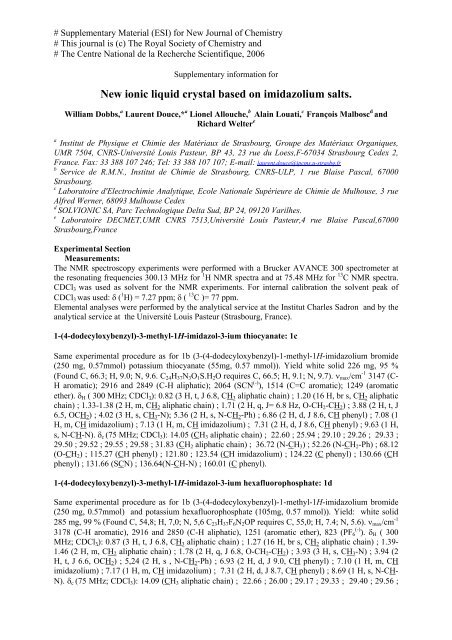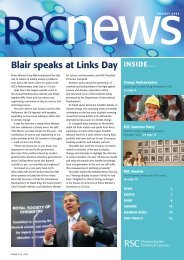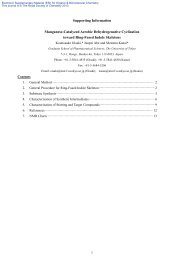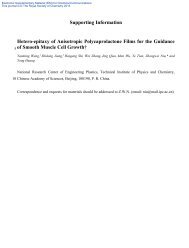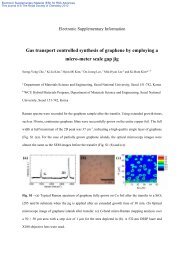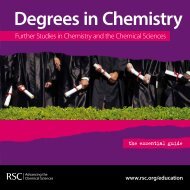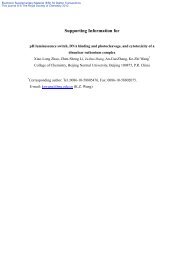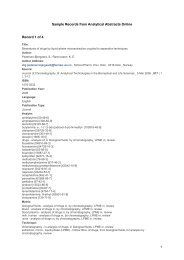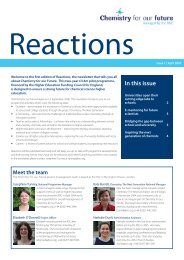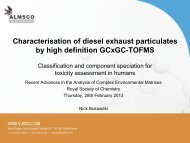New ionic liquid crystal based on imidazolium salts. - Royal Society ...
New ionic liquid crystal based on imidazolium salts. - Royal Society ...
New ionic liquid crystal based on imidazolium salts. - Royal Society ...
Create successful ePaper yourself
Turn your PDF publications into a flip-book with our unique Google optimized e-Paper software.
# Supplementary Material (ESI) for <str<strong>on</strong>g>New</str<strong>on</strong>g> Journal of Chemistry<br />
# This journal is (c) The <strong>Royal</strong> <strong>Society</strong> of Chemistry and<br />
# The Centre Nati<strong>on</strong>al de la Recherche Scientifique, 2006<br />
Supplementary informati<strong>on</strong> for<br />
<str<strong>on</strong>g>New</str<strong>on</strong>g> <str<strong>on</strong>g>i<strong>on</strong>ic</str<strong>on</strong>g> <str<strong>on</strong>g>liquid</str<strong>on</strong>g> <str<strong>on</strong>g>crystal</str<strong>on</strong>g> <str<strong>on</strong>g>based</str<strong>on</strong>g> <strong>on</strong> <strong>imidazolium</strong> <strong>salts</strong>.<br />
William Dobbs, a Laurent Douce,* a Li<strong>on</strong>el Allouche, b Alain Louati, c François Malbosc d and<br />
Richard Welter e<br />
a Institut de Physique et Chimie des Matériaux de Strasbourg, Groupe des Matériaux Organiques,<br />
UMR 7504, CNRS-Université Louis Pasteur, BP 43, 23 rue du Loess,F-67034 Strasbourg Cedex 2,<br />
France. Fax: 33 388 107 246; Tel: 33 388 107 107; E-mail: laurent.douce@ipcms.u-strasbg.fr<br />
b Service de R.M.N., Institut de Chimie de Strasbourg, CNRS-ULP, 1 rue Blaise Pascal, 67000<br />
Strasbourg.<br />
c Laboratoire d'Electrochimie Analytique, Ecole Nati<strong>on</strong>ale Supérieure de Chimie de Mulhouse, 3 rue<br />
Alfred Werner, 68093 Mulhouse Cedex<br />
d SOLVIONIC SA, Parc Technologique Delta Sud, BP 24, 09120 Varilhes.<br />
e Laboratoire DECMET,UMR CNRS 7513,Université Louis Pasteur,4 rue Blaise Pascal,67000<br />
Strasbourg,France<br />
Experimental Secti<strong>on</strong><br />
Measurements:<br />
The NMR spectroscopy experiments were performed with a Brucker AVANCE 300 spectrometer at<br />
the res<strong>on</strong>ating frequencies 300.13 MHz for 1 H NMR spectra and at 75.48 MHz for 13 C NMR spectra.<br />
CDCl3 was used as solvent for the NMR experiments. For internal calibrati<strong>on</strong> the solvent peak of<br />
CDCl3 was used: δ ( 1 H) = 7.27 ppm; δ ( 13 C )= 77 ppm.<br />
Elemental analyses were performed by the analytical service at the Institut Charles Sadr<strong>on</strong> and by the<br />
analytical service at the Université Louis Pasteur (Strasbourg, France).<br />
1-(4-dodecyloxybenzyl)-3-methyl-1H-imidazol-3-ium thiocyanate: 1c<br />
Same experimental procedure as for 1b (3-(4-dodecyloxybenzyl)-1-methyl-1H-<strong>imidazolium</strong> bromide<br />
(250 mg, 0.57mmol) potassium thiocyanate (55mg, 0.57 mmol)). Yield white solid 226 mg, 95 %<br />
(Found C, 66.3; H, 9.0; N, 9.6. C24H37N3O1S.H2O requires C, 66.5; H, 9.1; N, 9.7). νmax/cm -1 3147 (C-<br />
H aromatic); 2916 and 2849 (C-H aliphatic); 2064 (SCN (-) ), 1514 (C=C aromatic); 1249 (aromatic<br />
ether). δΗ ( 300 MHz; CDCl3)�: 0.82 (3 H, t, J 6.8, CH3 aliphatic chain) ; 1.20 (16 H, br s, CH2 aliphatic<br />
chain) ; 1.33-1.38 (2 H, m, CH2 aliphatic chain) ; 1.71 (2 H, q, J= 6.8 Hz, O-CH2-CH2) ; 3.88 (2 H, t, J<br />
6.5, OCH2) ; 4.02 (3 H, s, CH3-N); 5.36 (2 H, s, N-CH2-Ph) ; 6.86 (2 H, d, J 8.6, CH phenyl) ; 7.08 (1<br />
H, m, CH <strong>imidazolium</strong>) ; 7.13 (1 H, m, CH <strong>imidazolium</strong>) ; 7.31 (2 H, d, J 8.6, CH phenyl) ; 9.63 (1 H,<br />
s, N-CH-N). δc (75 MHz; CDCl3): 14.05 (CH3 aliphatic chain) ; 22.60 ; 25.94 ; 29.10 ; 29.26 ; 29.33 ;<br />
29.50 ; 29.52 ; 29.55 ; 29.58 ; 31.83 (CH2 aliphatic chain) ; 36.72 (N-CH3) ; 52.26 (N-CH2-Ph) ; 68.12<br />
(O-CH2) ; 115.27 (CH phenyl) ; 121.80 ; 123.54 (CH <strong>imidazolium</strong>) ; 124.22 (C phenyl) ; 130.66 (CH<br />
phenyl) ; 131.66 (SCN) ; 136.64(N-CH-N) ; 160.01 (C phenyl).<br />
1-(4-dodecyloxybenzyl)-3-methyl-1H-imidazol-3-ium hexafluorophosphate: 1d<br />
Same experimental procedure as for 1b (3-(4-dodecyloxybenzyl)-1-methyl-1H-<strong>imidazolium</strong> bromide<br />
(250 mg, 0.57mmol) and potassium hexafluorophosphate (105mg, 0.57 mmol)). Yield: white solid<br />
285 mg, 99 % (Found C, 54,8; H, 7,0; N, 5,6 C23H37F6N2OP requires C, 55,0; H, 7.4; N, 5.6). νmax/cm -1<br />
3178 (C-H aromatic), 2916 and 2850 (C-H aliphatic), 1251 (aromatic ether), 823 (PF6 (-) ). δΗ ( 300<br />
MHz; CDCl3)�: 0.87 (3 H, t, J 6.8, CH3 aliphatic chain) ; 1.27 (16 H, br s, CH2 aliphatic chain) ; 1.39-<br />
1.46 (2 H, m, CH2 aliphatic chain) ; 1.78 (2 H, q, J 6.8, O-CH2-CH2) ; 3.93 (3 H, s, CH3-N) ; 3.94 (2<br />
H, t, J 6.6, OCH2) ; 5,24 (2 H, s , N-CH2-Ph) ; 6.93 (2 H, d, J 9.0, CH phenyl) ; 7.10 (1 H, m, CH<br />
<strong>imidazolium</strong>) ; 7.17 (1 H, m, CH <strong>imidazolium</strong>) ; 7.31 (2 H, d, J 8.7, CH phenyl) ; 8.69 (1 H, s, N-CH-<br />
N). δc (75 MHz; CDCl3): 14.09 (CH3 aliphatic chain) ; 22.66 ; 26.00 ; 29.17 ; 29.33 ; 29.40 ; 29.56 ;
# Supplementary Material (ESI) for <str<strong>on</strong>g>New</str<strong>on</strong>g> Journal of Chemistry<br />
# This journal is (c) The <strong>Royal</strong> <strong>Society</strong> of Chemistry and<br />
# The Centre Nati<strong>on</strong>al de la Recherche Scientifique, 2006<br />
29.59 ; 29.61 ; 29.65 ; 31.90 (CH2 aliphatic chain) ; 36.21 (N-CH3) ; 53.09 (N-CH2-Ph) ; 68.17 (O-<br />
CH2) ; 115.35 (CH phenyl) ; 121.65 ; 123.95 (CH <strong>imidazolium</strong>) ; 123.95 (C phenyl) ; 130.57 (CH<br />
phenyl) ; 135.82 (N-CH-N) ; 160.13 (C phenyl).<br />
1-(4-dodecyloxybenzyl)-3-methyl-1H-imidazol-3-ium bis[(trifluoromethyl)sulf<strong>on</strong>yl]azanide: 1f<br />
Same experimental procedure as for 1b (3-(4-dodecyloxybenzyl)-1-methyl-1H-<strong>imidazolium</strong> bromide<br />
(250 mg, 0.57mmol) and lithium bis[(trifluoromethyl)sulf<strong>on</strong>yl]azanide (164mg, 0.57 mmol)). Yield:<br />
<str<strong>on</strong>g>crystal</str<strong>on</strong>g>line white solid 363 mg, 93 % (Found C, 47.15; H, 5.9; N, 6.6 C25H37F6N3O5S2 requires C, 47.1;<br />
H, 5.85; N, 6.6). νmax/cm -1 3156 (C-H aromatic), 2918 and 2848 (C-H aliphatic), 1517 (C=C aromatic),<br />
1353 and 1180 ([CF3SO2]2N - ). δΗ ( 300 MHz; CDCl3)�: 0.89 (3 H, t, J 6.8, CH3 aliphatic chain) ; 1.27<br />
(16 H, br s, CH2 aliphatic chain) ; 1.40-1.47 (2 H, m, CH2 aliphatic chain) ; 1.79 (2 H, m, O-CH2-CH2)<br />
; 3.96 (2 H, t, J 6.5, OCH2) ; 3.99 (3 H, s, CH3-N) ; 6.94 (2 H, d, J 8.6, CH phenyl) ; 7.12 (1 H, m, CH<br />
<strong>imidazolium</strong>) ; 7.16 (1 H, m, CH <strong>imidazolium</strong>) ; 7.31 (2 H, d, J 8.6, CH phenyl) ; 8.93 (1 H, s, N-CH-<br />
N). δc (75 MHz; CDCl3): 14.04 (CH3 aliphatic chain) ; 22.62 ; 25.95 ; 29.12 ; 29.29 ; 29.34 ; 29.52 ;<br />
29.55 ; 29.58 ; 29.60 ; 31.86 (CH2 aliphatic chain) ; 36.27 (N-CH3) ; 53.15 (N-CH2-Ph) ; 68.15 (O-<br />
CH2) ; 115.36 (CH phenyl) ; 119.76 (quadruplet, J= 321.2 Hz, CF3) 121.89 ; 123.70 (CH <strong>imidazolium</strong>)<br />
; 123.79 (C phenyl) ; 130.48 (CH phenyl) ; 135.63 (N-CH-N) ; 160.20 (C phenyl).
# Supplementary Material (ESI) for <str<strong>on</strong>g>New</str<strong>on</strong>g> Journal of Chemistry<br />
# This journal is (c) The <strong>Royal</strong> <strong>Society</strong> of Chemistry and<br />
# The Centre Nati<strong>on</strong>al de la Recherche Scientifique, 2006<br />
DOSY NMR 1 H experimental Secti<strong>on</strong><br />
NMR: Spectra were recorded <strong>on</strong> a Bruker Avance500 spectrometer, at 11.7 Tesla, at the res<strong>on</strong>ating<br />
frequencies of 500.13 MHz for 1 H. The diffusi<strong>on</strong> NMR experiments were performed with a Pulsed<br />
Field Gradient Stimulated Echo sequence, using bipolar gradients.(REF) The bipolar gradient durati<strong>on</strong><br />
and the diffusi<strong>on</strong> time were optimized (respectively 1 ms and 200 ms). The incremented pulsed field<br />
gradient was applied linearly between 1 and 50 G/cm. DOSY spectra were generated by the program<br />
GIFA 5.2 – DOSY module, developed by the NMRTec company, using adapted algorithms like invert<br />
Laplace transform and maximum entropy to build the diffusi<strong>on</strong> dimensi<strong>on</strong>.<br />
Figure S1: 1 H NMR DOSY spectrum of 1a at low c<strong>on</strong>centrati<strong>on</strong>. All diffusi<strong>on</strong> peaks are centred to<br />
700 µm 2 .s -1 , implying that the soluti<strong>on</strong> c<strong>on</strong>tains <strong>on</strong>e type of molecular object. Here, 1a is free in<br />
soluti<strong>on</strong>.<br />
(µm 2 .s -1 )<br />
2370 µm 2 .s -1 CDCl 3<br />
(ppm)<br />
700 µm 2 .s -1 1a
# Supplementary Material (ESI) for <str<strong>on</strong>g>New</str<strong>on</strong>g> Journal of Chemistry<br />
# This journal is (c) The <strong>Royal</strong> <strong>Society</strong> of Chemistry and<br />
# The Centre Nati<strong>on</strong>al de la Recherche Scientifique, 2006<br />
Figure S2: 1 H NMR DOSY spectrum of 1a at high c<strong>on</strong>centrati<strong>on</strong>. Diffusi<strong>on</strong> peaks are spread out from<br />
450 to 700 µm 2 .s -1 , implying that the soluti<strong>on</strong> c<strong>on</strong>tains several types of molecular object, bigger in size<br />
than 1a. The soluti<strong>on</strong> is a polydisperse mixture, composed by molecular aggregates.<br />
(µm 2 .s -1 )<br />
2370 µm 2 .s -1 CDCl 3<br />
(ppm)<br />
700 µm 2 .s -1<br />
450 µm 2 .s -1
# Supplementary Material (ESI) for <str<strong>on</strong>g>New</str<strong>on</strong>g> Journal of Chemistry<br />
# This journal is (c) The <strong>Royal</strong> <strong>Society</strong> of Chemistry and<br />
# The Centre Nati<strong>on</strong>al de la Recherche Scientifique, 2006<br />
Mesomorphic Secti<strong>on</strong><br />
The optical textures of the mesophases were studied with a Leitz polarizing microscope equipped<br />
with a Mettler FP80 hot -stage and an FP80 central processor. The transiti<strong>on</strong> temperatures and<br />
enthalpies were measured by differential scanning calorimetry with a Perkin-Elmer DSC-7 instrument<br />
operated at a scanning rate of 5 °C.min -1 <strong>on</strong> heating. The apparatus was calibrated with indium (156.6<br />
°C, 28.4 J.g -1 ) and gallium (29.8 °C) as the standards. The TGA measurements were carried out <strong>on</strong> a<br />
SDTQ 600 apparatus at scanning rate of 10 °C.min -1 . The transmissi<strong>on</strong> Guinier geometry was used for<br />
obtain the XRD patterns. In this case, a linear m<strong>on</strong>ochromatic Cu-Kα1 beam (λ = 1.5405 Å) was<br />
obtained using a sealed-tube generator (900 W) equipped with a bent quartz m<strong>on</strong>ochromator. For all<br />
compounds, the crude powder was filled in Lindemann capillaries of 1 mm diameter and the result<br />
was recorded <strong>on</strong> an image plate. In each case, exposure times were varied from 12 to 24 h.<br />
Figure S3: TGA measurements of all compounds 1a-f.<br />
1 st order
# Supplementary Material (ESI) for <str<strong>on</strong>g>New</str<strong>on</strong>g> Journal of Chemistry<br />
# This journal is (c) The <strong>Royal</strong> <strong>Society</strong> of Chemistry and<br />
# The Centre Nati<strong>on</strong>al de la Recherche Scientifique, 2006<br />
2 nd order<br />
3 rd order<br />
Figures S4 top: XRD plate image of 1b (BF4 - ); bottom: a more c<strong>on</strong>trasted view of the plate.
# Supplementary Material (ESI) for <str<strong>on</strong>g>New</str<strong>on</strong>g> Journal of Chemistry<br />
# This journal is (c) The <strong>Royal</strong> <strong>Society</strong> of Chemistry and<br />
# The Centre Nati<strong>on</strong>al de la Recherche Scientifique, 2006<br />
1a<br />
Heat Flow (W/g)<br />
1c 1d<br />
Heat Flow (W/g)<br />
1e<br />
Heat Flow (W/g)<br />
2.0<br />
1.5<br />
1.0<br />
0.5<br />
0.0<br />
3<br />
2<br />
1<br />
0<br />
-1<br />
4<br />
3<br />
2<br />
1<br />
0<br />
-1<br />
53.57°C<br />
51.96°C<br />
114.2J/g<br />
80.66°C<br />
78.78°C<br />
101.4J/g<br />
-0.5<br />
20 40 60 80<br />
Temperature (°C)<br />
100 120<br />
Figure S5: DSC thermograms of 1a-1f. Phase transiti<strong>on</strong> temperatures (°C) and corresp<strong>on</strong>ding<br />
enthalpy (J/g) were measured from the 1 st heating cycle, except for the Liquid Crystal-Isotrope<br />
transiti<strong>on</strong> of 1a, which has been determined during the TGA experiment.<br />
188.13°C<br />
187.65°C<br />
2.173J/g<br />
0 50 100 150 200<br />
Temperature (°C)<br />
64.89°C<br />
92.23J/g<br />
66.76°C<br />
0 20 40 60 80 100 120<br />
Temperature (°C)<br />
1b<br />
Heat Flow (W/g)<br />
Heat Flow (W/g)<br />
1f<br />
Heat Flow (W/g)<br />
2.5<br />
2.0<br />
1.5<br />
1.0<br />
0.5<br />
0.0<br />
-0.5<br />
4<br />
3<br />
2<br />
1<br />
0<br />
-1<br />
3<br />
2<br />
1<br />
0<br />
-1<br />
65.29°C<br />
63.06°C<br />
64.25J/g<br />
76.72°C<br />
75.58°C<br />
83.16J/g<br />
147.93°C<br />
147.41°C<br />
1.217J/g<br />
0 20 40 60 80 100 120 140 160<br />
Temperature (°C)<br />
49.43°C<br />
48.27°C<br />
98.15J/g<br />
203.39°C<br />
202.00°C<br />
1.516J/g<br />
0 50 100 150 200 250<br />
Temperature (°C)<br />
0 20 40 60 80 100 120<br />
Temperature (°C)
# Supplementary Material (ESI) for <str<strong>on</strong>g>New</str<strong>on</strong>g> Journal of Chemistry<br />
# This journal is (c) The <strong>Royal</strong> <strong>Society</strong> of Chemistry and<br />
# The Centre Nati<strong>on</strong>al de la Recherche Scientifique, 2006<br />
Electrochemical Secti<strong>on</strong><br />
Figure S6 Cyclic voltammograms of <str<strong>on</strong>g>i<strong>on</strong>ic</str<strong>on</strong>g> <str<strong>on</strong>g>liquid</str<strong>on</strong>g>s 1a-1f in CH3CN (0.1 M NBu4PF6). Scan rate 100<br />
mV s -1 .


